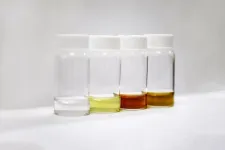(Press-News.org) SPOKANE, Wash. - Harm reduction treatment helped people experiencing homelessness and alcohol use disorder reduce their drinking and improve their health-even if they didn't quit drinking alcohol.
In a randomized clinical trial, a research team led by Washington State University psychology professor Susan Collins studied more than 300 people from three Seattle homeless shelters and programs. Participants were randomly assigned to four groups receiving different services: the first group received behavioral harm reduction treatment, which is a form of collaborative counseling that does not require sobriety or drinking reduction, plus an anti-craving medication called naltrexone; the second had the counseling and a placebo; the third, the counseling alone; and the fourth served as a control group receiving regular services.
All three groups that received the behavioral harm reduction treatment over a three-month period saw more improvement than the control group--with the most improvement in the group that had both the counseling and the anti-craving medication.
"We found participants didn't have to stop drinking to start recovery," said Collins, lead author on the study published March 10 in the journal The Lancet Psychiatry. "We didn't ask participants to change their drinking in any particular way, but looking at the averages generated in our statistical models, we found that people who got the combined counseling and medication experienced a 59% reduction during their treatment in the number of drinks consumed on their heaviest drinking day."
Other improvements during the three-month treatment included a 43% reduction in overall alcohol-related harm, a 29% reduction in frequency of drinking and a 10% improvement in people's self-assessment of their physical health.
All participants were asked to fill out surveys at different intervals related to their alcohol use, health and quality of life. While the group that had counseling and medication showed statistically significant improvement on five out of six measures, the other two groups that had harm reduction counseling but no active medication showed statistically significant improvement on three out of the six measures.
The researchers also tested urine samples. Participants who received combined treatment and medication were almost three times more likely to have undetectable levels of an alcohol biomarker than those in the control group, meaning their drinking had declined significantly.
For over a decade, Collins and her co-authors from the University of Washington and the VA Puget Sound Health Care System, have been working together with people who use substances and community-based agencies to develop evidence-based behavioral harm reduction treatment for alcohol use disorder.
The treatment involves a set of three strategies to reduce the negative effects of alcohol use. First, interventionists support patients in setting their own treatment goals instead of dictating that they quit. Second, interventionists and patients discuss ways to stay safer and healthier even when drinking. Third, instead of just tracking sobriety, interventionists work with patients to collaboratively measure and track different kinds of alcohol-related harm that may be important to patients.
Collins said that traditional alcohol treatment programs that demand abstinence fail to help many people experiencing homelessness and alcohol use disorder. By some estimates, people who experience chronic homelessness and alcohol use disorder have, on average, undergone alcohol treatment 16 times in their lives.
"Oftentimes, these folks are labeled 'treatment failures,' but we started to realize after many years of doing this work, maybe it's us, the treatment system that's failing them, more than the other way around," said Collins. "What we do with harm reduction treatment is try to meet people where they are at. Instead of falling into this paternalistic, advice-giving approach that turns people off, we try to support them in reaching their own goals."
Many of the study participants had multiple goals, only some of which involved reducing drinking. As might be expected, the most common goal was finding more stable housing, but other goals included re-connecting with family, finding work and engaging in hobbies they once enjoyed.
While this study included people experiencing homelessness, the findings also hold potential for other people with alcohol use disorder, Collins said.
"This approach has the potential to help anybody who would like to change their alcohol use but might not be ready or able to stop entirely," said Collins. "We can do treatment in an incremental way that might be more sustainable and less demoralizing than going through these cycles, where people feel if they aren't able to stop drinking, they can't start recovery or they aren't good enough for our treatment system. Instead, it is our definition of recovery and our treatment system that needs to change."
INFORMATION:
This study was supported by a grant from the National Institute on Alcohol Abuse and Alcoholism and conducted in collaboration with several agencies, including the Downtown Emergency Service Center, Evergreen Treatment Services' REACH program, Pioneer Human Services at the former Dutch Shisler Sobering Support Center, Public Health - Seattle & King County, King County Behavioral Health and Recovery Division, and Catholic Housing Services.
There were no significant differences in health outcomes for pregnant women who were diagnosed with gestational diabetes or their babies using two different clinically recommended screening methods, according to results from a large-scale clinical trial conducted by Kaiser Permanente researchers and published in The New England Journal of Medicine.
Although there is evidence that treating pregnant women for gestational diabetes leads to improved health outcomes for mothers and their infants, there is no scientific consensus on how best to screen ...
Boston, MA - People who eat diets with higher amounts of healthy plant-based foods and lower amounts of less-healthy plant-based foods may reduce their risk of stroke compared to people with lower-quality diets, according to a new study led by researchers from Harvard T.H. Chan School of Public Health. They found that healthy plant-based diets--defined as rich in foods such as leafy greens, whole grains, and beans, and including lower levels of foods like refined grains, potatoes, and added sugars--may lower overall stroke risk by up to 10%.
"Our findings have important public health implications, suggesting that future nutrition policies to lower stroke risk should ...
University of Texas at Dallas chemist Dr. Jie Zheng has spent much of his career investigating gold nanoparticles for their potential impact in the field of nanomedicine. In new research, he and his colleagues show how these nanoparticles could play a key role in a simple blood test to detect acute liver damage earlier than current methods.
The study, published online Feb. 19 in the journal Science Advances, expands on corresponding author Zheng's work, which has previously demonstrated the use of nanoparticles for targeted delivery of cancer drugs and better understanding of kidney disease.
"Our goal is to make it simple for family ...
One of the most classic algorithmic problems deals with calculating the shortest path between two points. A more complicated variant of the problem is when the route traverses a changing network--whether this be a road network or the internet. For 40 years, an algorithm has been sought to provide an optimal solution to this problem. Now, computer scientist Christian Wulff-Nilsen of the University of Copenhagen and two research colleagues have come up with a recipe.
When heading somewhere new, most of us leave it to computer algorithms to help us find the best route, whether by using a car's GPS, or public transport and map apps on their phone. Still, there are times when a proposed route doesn't quite align with reality. This is because road networks, ...
A team of pediatricians at the Medical University of South Carolina (MUSC) was the first in the nation to enroll patients with multisystem inflammatory syndrome in children (MIS-C), a rare but life-threatening complication of COVID-19, in a trial of remestemcel-L. This investigational cell therapy, developed and manufactured by Mesoblast, New York, New York, had previously been shown safe and effective for other inflammatory conditions. The MUSC team reports in Pediatrics that the two children enrolled thus far showed significant improvement within 24 hours of remestemcel-L administration.
"While it appears to many people that COVID is no big deal ...
During the COVID-19 pandemic, people who recognize the connections they share with others are more likely to wear a mask, follow health guidelines and help people, even at a potential cost to themselves, a new University of Washington study shows.
Indeed, an identification with all humanity, as opposed to identification with a geographic area like a country or town, predicts whether someone will engage in "prosocial" behaviors particular to the pandemic, such as donating their own masks to a hospital or coming to the aid of a sick person.
The study, published March 10 in PLOS ONE, is drawn from about 2,500 responses, from more than 80 countries, to an online, international ...
Images
As far back as the Greek historian Herodotus, a group of people called the Scythians were considered highly mobile warrior nomads.
Scythian-era people lived across Eurasia from about 700 BCE to 200 BCE, and have long been considered highly mobile warriors who ranged widely across the steppe grasslands. Herodotus describes Scythian populations as living in wagons and engaging in raiding and warfare, and this view has persisted throughout history--supported by archeologists' observations of similar styles of horse harnesses, weapons, burial mounds and animal style motifs throughout ...
A study conducted by researchers at the University of São Paulo in Brazil shows that competition for nutrients and lack of cooperation among bacteria of the species Escherichia coli in the same population and in situations of food scarcity prevent mutants that are better adapted to the environment from flourishing, except those that organize in small groups. The phenomenon masks the emergence of novel bacterial variants, making the mutation rate seem lower than it is in fact.
Mutants constantly emerge and accumulate from one generation to the next. Mutation frequency determines the evolution of a given species. Understanding ...
The legalization of cannabis and the arrival of nonmedical fentanyl are fundamentally changing drug markets in North America. A large part of these changes relates to the ability to produce large quantities of the drugs at low costs, which has slashed wholesale prices for both drugs and retail prices for cannabis. A new analysis explores the effects of these changes on use. The analysis concludes that sharp declines in production costs for cannabis and opioids could dramatically reduce the price per dose for consumers in ways that alter patterns of use and dependence.
The analysis, by a researcher at Carnegie Mellon University (CMU), is published in the International Journal of Drug Policy.
"Historical analogies suggest that very large ...
On December 6, 2016, a high-energy particle called an electron antineutrino was hurtling through space at nearly the speed of light. Normally, the ghostly particle would zip right through the Earth as if it weren't even there.
But this particle just so happened to smash into an electron deep inside the South Pole's glacial ice. The collision created a new particle, known as the W- boson. That boson quickly decayed, creating a shower of secondary particles.
The whole thing played out in front of the watchful detectors of a massive telescope buried in the Antarctic ice, the IceCube Neutrino Observatory. This enabled IceCube ...





